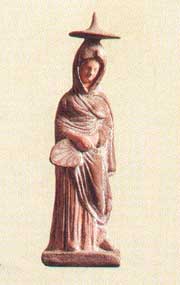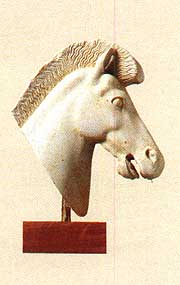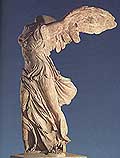Sculpture and framework
  Greek sculptors made statues and carvings for temples, tombs and
monuments. The most common subjects were gods, goddesses and heroes. Statues were made
from a variety of materials, including marble, limestone, bronze, wood, terracotta, ivory
and gold. Most of the surviving statues were made of stone. Many bronze statues were
melted down and the metal reused. Greek sculptors made statues and carvings for temples, tombs and
monuments. The most common subjects were gods, goddesses and heroes. Statues were made
from a variety of materials, including marble, limestone, bronze, wood, terracotta, ivory
and gold. Most of the surviving statues were made of stone. Many bronze statues were
melted down and the metal reused.  |
| 
|
Archaic Period
Statues from the Archaic Period look stiff and formal. They were based on Egyptian and
eastern styles. The statues are of three main types: The seated figure, the kouros
(standing youth) and the kore (standing girl) |
 |
 Classical
Period
Classical
Period
By Classical Times, the Greeks had learned how to portray the human body in a
completely life-like way. Skilled portraits of important people began to be made as well
as sculptures showing scenes and actions. Faces in the scenes often showed expression and
emotion, although the ones in portraits were always calm and composed. Clothes and drapes
were sculpted with graceful, natural folds.
 Hellenistic
Period
Hellenistic
Period
By the Hellenistic Period, a much wider range of subjects was chosen. Outstanding
portraits were produced and children, foreigners, old age and suffering were depicted in a
realistic way.
Terracottas
Terracottas are small statues made of baked clay. The early ones were made
individually, but later some were made in moulds. Terracottas were brightly painted and
were usually made as offerings to the gods of the dead. Their style was ranging from the
early, rather stiff looking figures, to the later ones, some of which show everyday
scenes.

 Metalwork
Metalwork
Gold, silver, bronze and iron were used to make a wide range of tableware, jewellery,
weapons and other objects. Goods made by Greek craftsmen were in great demand abroad, and
have been found by archaeologists all over Europe, South Russia and in the Near and Middle
East.

 Greek sculptors made statues and carvings for temples, tombs and
monuments. The most common subjects were gods, goddesses and heroes. Statues were made
from a variety of materials, including marble, limestone, bronze, wood, terracotta, ivory
and gold. Most of the surviving statues were made of stone. Many bronze statues were
melted down and the metal reused.
Greek sculptors made statues and carvings for temples, tombs and
monuments. The most common subjects were gods, goddesses and heroes. Statues were made
from a variety of materials, including marble, limestone, bronze, wood, terracotta, ivory
and gold. Most of the surviving statues were made of stone. Many bronze statues were
melted down and the metal reused. 


 Classical
Period
Classical
Period Hellenistic
Period
Hellenistic
Period
 Metalwork
Metalwork